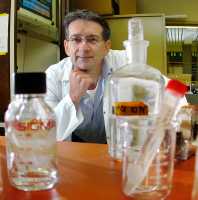03 Sep Wild Blueberry Polyphenols May Help Fight Periodontal Disease
MedicalResearch.com Interview with:
Daniel Grenier, Ph.D.
Professeur titulaire
Oral Ecology Research Group, Faculty of Dentistry, and Institute of Nutrition and Functional Foods, Université Laval
Quebec City, QC, Canada
Medical Research: What is the background for this study?
Dr. Grenier: Periodontal diseases (gingivitis and periodontitis) are major public health problems because of their high prevalence and incidence in all regions of the world. According to epidemiological studies, approximately 5% of North Americans suffer from severe generalized periodontitis, which can lead to tooth loss, while mild to moderate periodontitis affects up to 35% of adults. Given emerging data indicating that there is a relationship between periodontal diseases and systemic health problems such as diabetes, cardiovascular diseases, and preterm birth, studies on preventive and therapeutic strategies targeting periodontal diseases are highly relevant.
Medical Research: What are the main findings?
Dr. Grenier: Using various in vitro models, we brought clear evidence that a blueberry extract enriched in proanthocyanidins can act on the two etiological components of periodontal disease. We first showed that these polyphenols inhibit the growth of Fusobacterium nucleatum as well as its ability to form a biofilm, which can provide to the bacterium a resistance to antimicrobial agents and immune cells. Interestingly, F. nucleatum has been associated with various forms of periodontitis as well as to a number of extra-oral infections, including endocarditis, inflammatory bowel disease, and brain abscesses. Moreover, the blueberry extract attenuated the inflammatory response of human macrophages challenged with F. nucleatum, resulting in a decreased secretion of inflammatory cytokines (IL-1β, IL-6, TNF-α) and tissue destructive enzymes (MMP-8, MMP-9). Evidence was brought that this property is likely related to the ability of the blueberry polyphenols to block the activation of the NF-κB signaling pathway that play a key role in inflammatory reactions.
Over the last decade, my laboratory has been investigating the potential benefits of various classes of polyphenols for oral health. Polyphenols are a large group of natural substances found in plants and characterized by the presence of more than one phenol unit per molecule. Given that wild blueberries (Vaccinium angustifolium Ait), a popular berry fruit in Quebec, are particularly rich in a specific class of polyphenols, called proanthocyanidins, we tested their effect on the two major etiological factors involved in the pathogenesis of periodontitis: a limited group of Gram negative anaerobic bacteria, and an uncontrolled host immune response to these pathogens that results in the secretion of high amounts of inflammatory mediators which modulate the progression and severity of periodontitis.
Medical Research: What should clinicians and patients take away from your report?
Dr. Grenier: This dual anti-bacterial and anti-inflammatory action of wild blueberry polyphenols suggests that they may be promising candidates for novel therapeutic agents against periodontal diseases. However, results obtained in vitro are difficult to transpose to the in vivo situation, since the oral environment could interfere with the biological properties of these molecules. Consequently, clinical studies in this area are warranted.
Medical Research: What recommendations do you have for future research as a result of this study?
Dr. Grenier: Studies aimed to isolate and characterize the bioactive molecules found in the blueberry extract are currently in progress. These molecules could then be used for localized application into diseased periodontal sites, through irrigation or insertion of a slow-release drug device. The bioactive molecules may also be incorporated into oral hygiene products (mouthrinse, chewing gum, which could be tested in human clinical studies for their potential benefits in preventing periodontal diseases.
Studies in progress in my laboratory are also testing the polyphenols from the highbush blueberry species (Vaccinium corymbosum) for similar properties as well as for their benefits against dental caries.
Citation:
J Agric Food Chem. 2015 Aug 12;63(31):6999-7008. doi: 10.1021/acs.jafc.5b01525. Epub 2015 Aug 4.
Ben Lagha A1, Dudonné S1, Desjardins Y1, Grenier D1.
[wysija_form id=”5″]
MedicalResearch.com is not a forum for the exchange of personal medical information, advice or the promotion of self-destructive behavior (e.g., eating disorders, suicide). While you may freely discuss your troubles, you should not look to the Website for information or advice on such topics. Instead, we recommend that you talk in person with a trusted medical professional.
The information on MedicalResearch.com is provided for educational purposes only, and is in no way intended to diagnose, cure, or treat any medical or other condition. Always seek the advice of your physician or other qualified health and ask your doctor any questions you may have regarding a medical condition. In addition to all other limitations and disclaimers in this agreement, service provider and its third party providers disclaim any liability or loss in connection with the content provided on this website.
Daniel Grenier, Ph.D. (2015). Wild Blueberry Polyphenols May Help Fight Periodontal Disease
Last Updated on September 3, 2015 by Marie Benz MD FAAD

